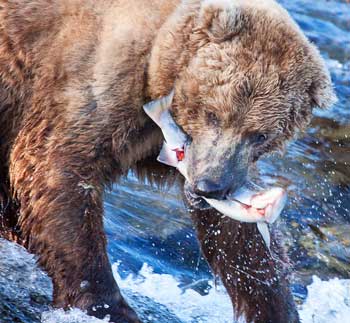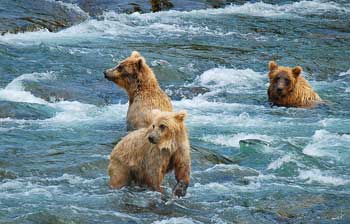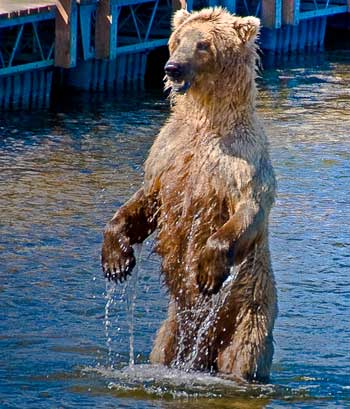The Bears of Katmai
Alaska brown bears were everywhere! We had difficulty deciding where to focus our attention first. We were perched on a viewing platform 10′ above the river with a dozen or so other visitors. One huge male bear ambled upstream into the warm sunshine of a July afternoon. He strode to the 15-foot waterfall, ambled up the rocks on the near-bank side, and then took a stance in the river at the very brink of the falls. Soon, we saw a salmon appear from the froth below and launch itself up the cascade – the bear leaned out, snared the fish in its mouth, and then retreated upstream with its meal. The fish was still struggling between the bear’s jaws, its fish mouth opening and closing as if in protest. I felt as if I was inside a National Geographic documentary.
We have visited Katmai National Park, on the Alaska peninsula, twice. The first time, it was only as a day trip. We had returned this time for three days– spending the nights in one of the cabins at nearby Brooks Lodge. Katmai is where the bears are– in numbers hard to comprehend.
The brown bears of Katmai are much larger, salmon-eating, coastal-dwelling grizzlies. When the fish are running, bears congregate between the mouth of the river and Brooks Falls. One evening we counted 16 bears in our immediate vicinity.
After years of hiking and backpacking in Yellowstone Park and Glacier National Park– and having grizzly avoidance procedures drilled into us– finding ourselves surrounded by the huge animals was a surreal experience. At Katmai the bears have the right-of-way and park rangers manage the people. The viewing platform is at the end of a gated boardwalk. However, getting to the boardwalk involves walking about a mile on a forested trail frequented by bears. Before we were allowed on the trail, we had to attend the ranger-presented “bear school”. Here we learned how to live with and observe the bears without disturbing them.
This peaceful co-existence between bears and people depends on the people behaving in a predictable manner. During the daytime, the rangers keep close watch on where each bear is, and maintain radio contact with each other. A bridge near the beginning of the trail is a frequent bear-jam spot. Rangers warn that at Katmai, everything runs on bear time. It was not unusual to wait many minutes for the bridge area to be bear-free so visitors could cross. On one occasion, when large schools of fish were congregating in the river below, there were so many bears fishing near the bridge that we had to wait over an hour to get across. Any required wait was worth it. A lower, bridge platform looks out over nearby riffles where a sow with her cubs were frequently seen fishing and playing.
The upper falls, though, is where the action is. Here we were witness to an ancient ritual. Salmon that have escaped the talons of osprey and eagles, survived the outstretched lines of fishermen and battled waterfalls and currents, must now run the gauntlet of the bears in order to spawn and pass their genes on to the next generation. The bears develop their own techniques for fishing – we watched them splashing to scare up the fish, or snorkeling with their head under water. However, the most exciting, was watching the bears standing at the top of the falls, snatching fish in mid-air.
Katmai isn’t solely about the bears, though. In fact, the park was originally designated to preserve the Valley of the 10,000 Smokes – created by a volcanic eruption in 1912. The blast has been estimated at ten times the force of Mt. Saint Helens’ 1980 eruption. It left ash deposits 700 feet deep. A 23-mile bus tour took us into the interior. There a trail led us down to a powerful waterfall that had carved its way through the delicate pastel colors of the ash deposits. The park, which is only accessible by boat or floatplane, also contains other wildlife: moose inhabit the marshy areas and one morning we watched a wolf prowl the water’s edge.
While Katmai has many attractions, the bears are the stars. On that first afternoon, when we stood watching the bear at the top of the falls, we saw it catch and eat four fish. At first we found ourselves rooting for the bear; applauding when it was successful. Eventually, we started to feel sorry for the salmon. Then we realized that we weren’t really supposed to root for anyone in this contest; it is just a cycle of life. For three days, it was our privilege to observe it.
These amazing photos were taken by Skip & Gayle Stokes.





Great pictures, very informative article to read. Thanks